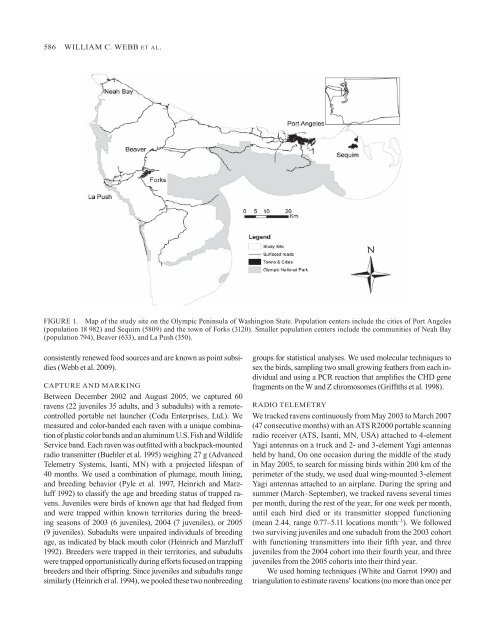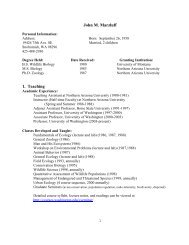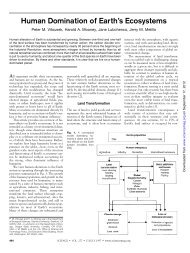DIFFERENCES IN SPACE USE by COMMON RAVENS IN ...
DIFFERENCES IN SPACE USE by COMMON RAVENS IN ...
DIFFERENCES IN SPACE USE by COMMON RAVENS IN ...
- No tags were found...
Create successful ePaper yourself
Turn your PDF publications into a flip-book with our unique Google optimized e-Paper software.
586 William C. Webb et al.FIGURE 1. Map of the study site on the Olympic Peninsula of Washington State. Population centers include the cities of Port Angeles(population 18 982) and Sequim (5809) and the town of Forks (3120). Smaller population centers include the communities of Neah Bay(population 794), Beaver (633), and La Push (350).consistently renewed food sources and are known as point subsidies(Webb et al. 2009).Capture and markingBetween December 2002 and August 2005, we captured 60ravens (22 juveniles 35 adults, and 3 subadults) with a remotecontrolledportable net launcher (Coda Enterprises, Ltd.). Wemeasured and color-banded each raven with a unique combinationof plastic color bands and an aluminum U.S. Fish and WildlifeService band. Each raven was outfitted with a backpack-mountedradio transmitter (Buehler et al. 1995) weighing 27 g (AdvancedTelemetry Systems, Isanti, MN) with a projected lifespan of40 months. We used a combination of plumage, mouth lining,and breeding behavior (Pyle et al. 1997, Heinrich and Marzluff1992) to classify the age and breeding status of trapped ravens.Juveniles were birds of known age that had fledged fromand were trapped within known territories during the breedingseasons of 2003 (6 juveniles), 2004 (7 juveniles), or 2005(9 juveniles). Subadults were unpaired individuals of breedingage, as indicated <strong>by</strong> black mouth color (Heinrich and Marzluff1992). Breeders were trapped in their territories, and subadultswere trapped opportunistically during efforts focused on trappingbreeders and their offspring. Since juveniles and subadults rangesimilarly (Heinrich et al. 1994), we pooled these two nonbreedinggroups for statistical analyses. We used molecular techniques tosex the birds, sampling two small growing feathers from each individualand using a PCR reaction that amplifies the CHD genefragments on the W and Z chromosomes (Griffiths et al. 1998).Radio telemetryWe tracked ravens continuously from May 2003 to March 2007(47 consecutive months) with an ATS R2000 portable scanningradio receiver (ATS, Isanti, MN, USA) attached to 4-elementYagi antennas on a truck and 2- and 3-element Yagi antennasheld <strong>by</strong> hand, On one occasion during the middle of the studyin May 2005, to search for missing birds within 200 km of theperimeter of the study, we used dual wing-mounted 3-elementYagi antennas attached to an airplane. During the spring andsummer (March–September), we tracked ravens several timesper month, during the rest of the year, for one week per month,until each bird died or its transmitter stopped functioning(mean 2.44, range 0.77–5.11 locations month –1 ). We followedtwo surviving juveniles and one subadult from the 2003 cohortwith functioning transmitters into their fifth year, and threejuveniles from the 2004 cohort into their fourth year, and threejuveniles from the 2005 cohorts into their third year.We used homing techniques (White and Garrot 1990) andtriangulation to estimate ravens’ locations (no more than once per
















